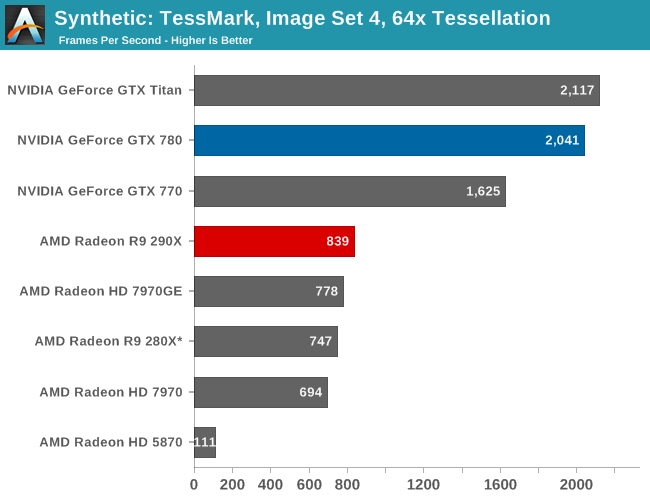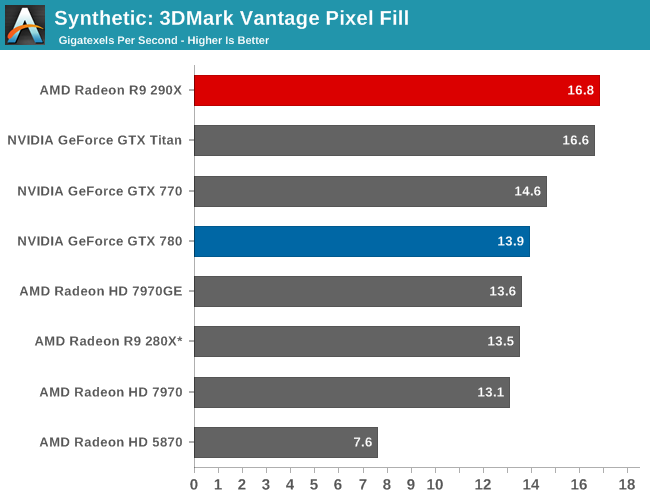The AMD Radeon R9 290X Review
by Ryan Smith on October 24, 2013 12:01 AM EST- Posted in
- GPUs
- AMD
- Radeon
- Hawaii
- Radeon 200
Synthetics
As always we’ll also take a quick look at synthetic performance. The 290X shouldn’t pack any great surprises here since it’s still GCN, and as such bound to the same general rules for efficiency, but we do have the additional geometry processors and additional ROPs to occupy our attention.

Right off the bat then, the TessMark results are something of a head scratcher. Whereas NVIDIA’s performance here has consistently scaled well with the number of SMXes, AMD’s seeing minimal scaling from those additional geometry processors on Hawaii/290X. Clearly Tessmark is striking another bottleneck on 290X beyond simple geometry throughput, though it’s not absolutely clear what that bottleneck is.
This is a tessellation-heavy benchmark as opposed to a simple massive geometry bencehmark, so we may be seeing a tessellation bottleneck rather than a geometry bottleneck, as tessellation requires its own set of heavy lifting to generate the necessary control points. The 12% performance gain is much closer to the 11% memory bandwidth gain than anything else, so it may be that the 280X and 290X are having to go off-chip to store tessellation data (we are after all using a rather extreme factor), in which case it’s a memory bandwidth bottleneck. Real world geometry performance will undoubtedly be better than this – thankfully for AMD this is the pathological tessellation case – but it does serve of a reminder of how much more tessellation performance NVIDIA is able to wring out of Kepler. Though the nearly 8x increase in tessellation performance since 5870 shows that AMD has at least gone a long way in 4 years, and considering the performance in our tessellation enabled games AMD doesn’t seem to be hurting for tessellation performance in the real world right now.
Moving on, we have our 3DMark Vantage texture and pixel fillrate tests, which present our cards with massive amounts of texturing and color blending work. These aren’t results we suggest comparing across different vendors, but they’re good for tracking improvements and changes within a single product family.

Looking first at texturing performance, we can see that texturing performance is essentially scaling 1:1 with what the theoretical numbers say it should. 36% better texturing performance over 280X is exactly in line with the increased number of texture units versus 280X, at the very least proving that 290X isn’t having any trouble feeding the increased number of texture units in this scenario.

Meanwhile for our pixel fill rates the results are a bit more in the middle, reflecting the fact that this test is a mix of ROP bottlenecking and memory bandwidth bottlenecking. Remember, AMD doubled the ROPs versus 280X, but only gave it 11% more memory bandwidth. As a result the ROPs’ ability to perform is going to depend in part on how well color compression works and what can be recycled in the L2 cache, as anything else means a trip to the VRAM and running into those lesser memory bandwidth gains. Though the 290X does get something of a secondary benefit here, which is that unlike the 280X it doesn’t have to go through a memory crossbar and any inefficiencies/overhead it may add, since the number of ROPs and memory controllers is perfectly aligned on Hawaii.










396 Comments
View All Comments
heflys - Thursday, October 24, 2013 - link
Slightly slower than a 780 overall? Even in Uber mode? Can you link me to these reviews if possible?Shark321 - Thursday, October 24, 2013 - link
I didn't say that. It's slightly slower in Uber Mode than Titan overall in 1080p (across all sites combined). In Quiet mode it's usually slightly faster than 780, slighttly slower in the minority of the reviews.heflys - Thursday, October 24, 2013 - link
I see now.Jumangi - Thursday, October 24, 2013 - link
What noob would buy a 290x or a Titan and run it in 1080p? A pointless resolution for these cards.
inighthawki - Thursday, October 24, 2013 - link
What an arrogant post. There are tons of people who game on 1080p displays and buy a 290X or a Titan. Having a high framerate (i.e. consistently greater than 60fps) reduces the likelihood of stuttering while playing, while also making your system a bit more future-proof as new games come out. Not everyone cares about pixel count, some care more about quality per pixel. As you start seeing titles ship on Unreal 4, post-Crysis 3, etc, I will be laughing at you when I can still run my games at native resolution without the need to upscale or reduce quality.puppies - Saturday, October 26, 2013 - link
Anyone who buys a titan to play games at 1080p is insane, seriously they need locking up. You claiming otherwise does nothing.Samus - Thursday, October 24, 2013 - link
agreed. this card is for 2560x1440+ or multimonitorTheJian - Friday, October 25, 2013 - link
ROFL...Only if you don't believe in MAXING your games. Which nobody can do with a single card. Many sites comment on this, and show mins, even here with lower settings they hit below 30fps in a few of their games at 2560. In multiplayer you'd get crushed by guys hitting much higher fps at 1080p in many games. Maybe you'll be right at 20nm, but certainly there are far too many games you have to jockey settings around on to make you right today.reddev - Thursday, October 24, 2013 - link
Both LinusTechTips and OC3D, two reviewers I trust quite a bit, have it below the 780.randomhkkid - Friday, October 25, 2013 - link
Linus tech tips over clocks all the cards it tests, since the 780 has much more headroom (on the stick cooler) the gains were larger than the 290x so at stock the 290x is faster.